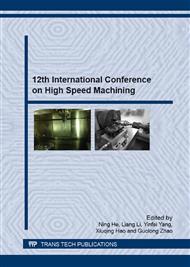p.29
p.36
p.43
p.48
p.56
p.64
p.71
p.77
p.88
Time Dependent Behavior Analysis of Inconel 718 in High Speed Grinding Process
Abstract:
The time dependent behavior of grinding is expressed as the change of process output measures as a function of time during grinding. Although the wheel capability will be restored by dressing, the time dependent behavior of grinding during one dressing skip is determinant on the grinding quality variation in terms of surface integrity and workpiece geometric accuracy. Therefore, understanding of grinding time dependent behavior in relation with the wheel-workpiece microscopic interaction is critical for wheel and process development to achieve stable grinding processes. In this paper, the high speed grinding of inconel 718 with cBN grinding wheels is carried out. The time dependent behavior is recorded to represent the characteristic features. And the microscopic wheel topography is measured under SEM throughout the whole grinding process so as to reveal the root cause for the time dependent behavior and its impact on the workpiece quality variation.
Info:
Periodical:
Pages:
56-63
Citation:
Online since:
January 2016
Authors:
Keywords:
Price:
Сopyright:
© 2016 Trans Tech Publications Ltd. All Rights Reserved
Share:
Citation:


